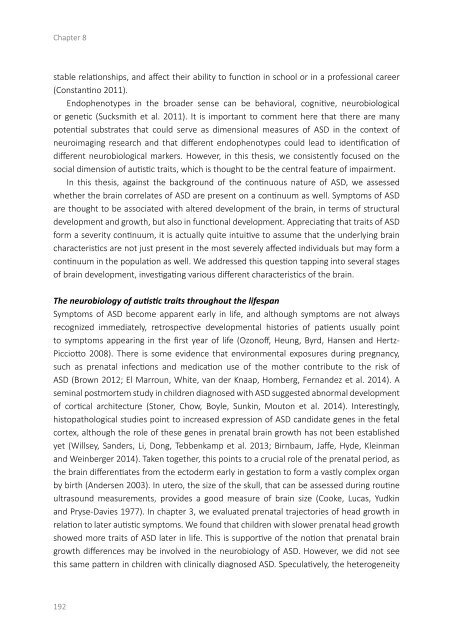On the Spectrum
2lm5UyR
2lm5UyR
You also want an ePaper? Increase the reach of your titles
YUMPU automatically turns print PDFs into web optimized ePapers that Google loves.
Chapter 8<br />
stable relationships, and affect <strong>the</strong>ir ability to function in school or in a professional career<br />
(Constantino 2011).<br />
Endophenotypes in <strong>the</strong> broader sense can be behavioral, cognitive, neurobiological<br />
or genetic (Sucksmith et al. 2011). It is important to comment here that <strong>the</strong>re are many<br />
potential substrates that could serve as dimensional measures of ASD in <strong>the</strong> context of<br />
neuroimaging research and that different endophenotypes could lead to identification of<br />
different neurobiological markers. However, in this <strong>the</strong>sis, we consistently focused on <strong>the</strong><br />
social dimension of autistic traits, which is thought to be <strong>the</strong> central feature of impairment.<br />
In this <strong>the</strong>sis, against <strong>the</strong> background of <strong>the</strong> continuous nature of ASD, we assessed<br />
whe<strong>the</strong>r <strong>the</strong> brain correlates of ASD are present on a continuum as well. Symptoms of ASD<br />
are thought to be associated with altered development of <strong>the</strong> brain, in terms of structural<br />
development and growth, but also in functional development. Appreciating that traits of ASD<br />
form a severity continuum, it is actually quite intuitive to assume that <strong>the</strong> underlying brain<br />
characteristics are not just present in <strong>the</strong> most severely affected individuals but may form a<br />
continuum in <strong>the</strong> population as well. We addressed this question tapping into several stages<br />
of brain development, investigating various different characteristics of <strong>the</strong> brain.<br />
The neurobiology of autistic traits throughout <strong>the</strong> lifespan<br />
Symptoms of ASD become apparent early in life, and although symptoms are not always<br />
recognized immediately, retrospective developmental histories of patients usually point<br />
to symptoms appearing in <strong>the</strong> first year of life (Ozonoff, Heung, Byrd, Hansen and Hertz-<br />
Picciotto 2008). There is some evidence that environmental exposures during pregnancy,<br />
such as prenatal infections and medication use of <strong>the</strong> mo<strong>the</strong>r contribute to <strong>the</strong> risk of<br />
ASD (Brown 2012; El Marroun, White, van der Knaap, Homberg, Fernandez et al. 2014). A<br />
seminal postmortem study in children diagnosed with ASD suggested abnormal development<br />
of cortical architecture (Stoner, Chow, Boyle, Sunkin, Mouton et al. 2014). Interestingly,<br />
histopathological studies point to increased expression of ASD candidate genes in <strong>the</strong> fetal<br />
cortex, although <strong>the</strong> role of <strong>the</strong>se genes in prenatal brain growth has not been established<br />
yet (Willsey, Sanders, Li, Dong, Tebbenkamp et al. 2013; Birnbaum, Jaffe, Hyde, Kleinman<br />
and Weinberger 2014). Taken toge<strong>the</strong>r, this points to a crucial role of <strong>the</strong> prenatal period, as<br />
<strong>the</strong> brain differentiates from <strong>the</strong> ectoderm early in gestation to form a vastly complex organ<br />
by birth (Andersen 2003). In utero, <strong>the</strong> size of <strong>the</strong> skull, that can be assessed during routine<br />
ultrasound measurements, provides a good measure of brain size (Cooke, Lucas, Yudkin<br />
and Pryse-Davies 1977). In chapter 3, we evaluated prenatal trajectories of head growth in<br />
relation to later autistic symptoms. We found that children with slower prenatal head growth<br />
showed more traits of ASD later in life. This is supportive of <strong>the</strong> notion that prenatal brain<br />
growth differences may be involved in <strong>the</strong> neurobiology of ASD. However, we did not see<br />
this same pattern in children with clinically diagnosed ASD. Speculatively, <strong>the</strong> heterogeneity<br />
192


